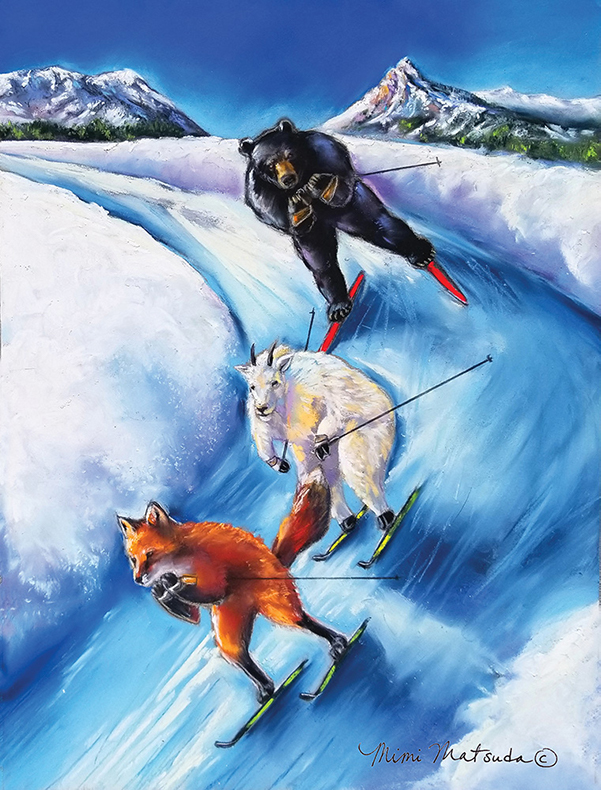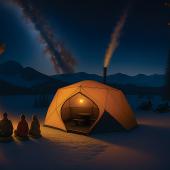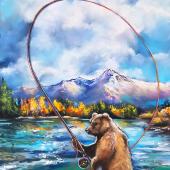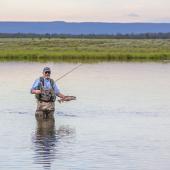Instant Impact
Artist Mimi Matsuda talks inspiration.
Montana’s stunning landscapes and abundant wildlife have long inspired a variety of artists, from painters to poets. It was no different for Mimi Matsuda, whose whimsical work has come to represent Bozeman’s paired penchant for recreation and conservation. We caught up with the painter to talk inspiration.
O/B: What brought you to Bozeman?
MM: After graduating from Portland State University in Oregon, I drove out to work in Yellowstone. The first summer I worked in fisheries for the National Park Service and enjoyed seeing trout first-hand. I made the jump to Bozeman after many years of migrating seasonally from my NPS work to Oregon and back. Bozeman was the best place to set down roots and focus on my art career. It’s stunningly beautiful, and has wildlife and year-round recreation right out the back door. We are lucky to have national parks, Wilderness Areas, state parks, and wildlife refuges all at hand. I draw on these wild places as fuel for my art.
O/B: How does recreation influence your work? What opportunities has recreation provided?
MM: Recreation brings inspiration and thinking time to dream up my art. It’s vital for people to have open space and natural surroundings so they can re-set and get back in sync with the pulse of the natural world. So much of my whimsical animal art is outdoor-sports related because I draw so much joy from those sports. My aim is two-pronged: to draw people’s attention to wildlife and their importance as our neighbors, and to bring [animals] closer to our attention by having them do outdoor sports that we enjoy.
O/B: Do you draw on your own outdoor passions when creating a piece?
MM: Absolutely. I put myself into the mindset or viewpoint of my subject matter when I paint my animals. I paint and draw what I know. I put myself in their place and try my best to capture the focus, fun, and pure joy of the moment. I enjoy working out the details from what animal would fit best in the painting, what would the animal look like while partaking in the sport, and deciding on a meaningful title. There is endless subject matter and so many stories to paint here in Montana. Also, Bozeman is such a family-oriented town and a lot of my art centers on parents sharing outdoors and sports with their children. It’s important to grow up close to nature.

"Outfoxed" by Mimi Matsuda
O/B: What message are you trying to send with your work, if any?
MM: I communicate in imagery and think the message is up to each individual. Every person will bring different meaning to each piece of art. There’s the immediate surface story of the art and then the deeper meaning. I want to catch people’s attention first with bold color and the animals’ gaze. Then the viewers put the story together in their minds. At art shows I hear how people relate to the animal in the painting. So many times they say that they are the animal in the painting or see their family or friends. I feel the big-picture message of my art is that we are lucky to live in this beautiful place and enjoy outdoor pursuits and see wild animals. Enjoy these times, stay in the moment, share it with friends and family, and realize that the land and animals are important. Keep it that way and take care of it.
O/B: Do you think art has a role in advocating for conservation, recreation, and access? If so, what?
MM: Yes. We are a visual species and have been storytelling with pictures forever. Artists have been making people aware of significant wild places and species on the brink of extinction for many generations back in time. One can read powerful written words and be moved to act. Visual art, on the other hand, has instantaneous impact where the viewer sees and feels immediately. I’ve watched international visitors, from toddlers to grandparents, stop and chat about my art. The wonderful thing about art is that it’s a universal language and speaks to all ages. We are lucky enough to share this place with wild animals. Their lives are as authentic and as worthy as our own. Let’s not forget that they make this place that much richer.
The same goes for conservation of habitat. We will not have wildlife without healthy and plentiful habitat. We need to think big and inclusive and try our best to take actions that respect the whole landscape. As recreationists, we are guests in wild places. I hope that people don’t take wild places and wild animals for granted. We are lucky to live in the Greater Yellowstone and we are all stewards of this special place.
Lastly, I appreciate my viewers who come to my shows and speak up about what art moves them and what they would like to see. I have seen that people need wildlife in their lives. It gives them strength, hope, makes them happy, fills a need, and brings such joy.












